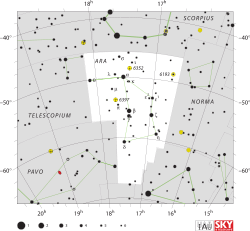Beta Arae

| |
| Observation data Epoch J2000 Equinox J2000 | |
|---|---|
| Constellation | Ara |
| Right ascension | 17h 25m 17.98835s[1] |
| Declination | −55° 31′ 47.5868″[1] |
| Apparent magnitude (V) | 2.84[2] |
| Characteristics | |
| Spectral type | K3 Ib-IIa[3] |
| U−B color index | +1.56[4] |
| B−V color index | +1.46[4] |
| Astrometry | |
| Radial velocity (Rv) | -0.30 ± 0.20[3] km/s |
| Proper motion (μ) | RA: −8.51[1] mas/yr Dec.: −25.24[1] mas/yr |
| Parallax (π) | 5.05 ± 0.64[1] mas |
| Distance | approx. 650 ly (approx. 200 pc) |
| Details | |
| Mass | 6.8 ± 0.4[5] M☉ |
| Surface gravity (log g) | 1.3[6] cgs |
| Temperature | 4,582[6] K |
| Metallicity [Fe/H] | +0.50[6] dex |
| Rotational velocity (v sin i) | 5.4 ± 1.0[3] km/s |
| Age | 50.1 ± 4.4[5] Myr |
| Other designations | |
Beta Arae (β Ara, β Arae) is the brightest star in the constellation Ara, with an apparent visual magnitude of 2.8.[2] Parallax measurements place it at a distance of roughly 650 light-years (200 parsecs) from Earth.[1]
The spectrum of this star matches a stellar classification of K3 Ib-IIa,[3] with the luminosity class notation 'Ib-IIa' indicating that the star lies part way between a higher luminosity bright giant (IIa) and a lower luminosity supergiant (Ib). This represents two of the evolutionary stages that a massive star passes through after it has exhausted the hydrogen at its core. Beta Arae is radiating energy from its outer envelope at an effective temperature of 4,582 K,[6] which causes it to take on the orange hue of a K-type star.[8] This enlarged star appears to be rotating slowly with a projected rotational velocity of about 5 km s−1.[3] The abundance of elements other than hydrogen and helium, what astronomer term the star's metallicity, is more than three times the abundance in the Sun.[3][9]
Rarely, this star is called by the name Vasat-ül-cemre in Turkish spelling, derived from Arabic word ﻭﺳﻂ (wasath) and ﺟﻤﻩﺮ (khamra), meaning "middle of fire".[10] In Chinese, 杵 (Chǔ), meaning Pestle, refers to an asterism consisting of β Arae, σ Arae and α Arae.[11] Consequently, β Arae itself is known as 杵三 (Chǔ sān, English: the Third Star of Pestle.)[12]
References
- ↑ 1.0 1.1 1.2 1.3 1.4 1.5 van Leeuwen, F. (November 2007), "Validation of the new Hipparcos reduction", Astronomy and Astrophysics 474 (2): 653–664, arXiv:0708.1752, Bibcode:2007A&A...474..653V, doi:10.1051/0004-6361:20078357
- ↑ 2.0 2.1 Wielen, R. et al. (1999), Sixth Catalogue of Fundamental Stars (FK6). Part I. Basic fundamental stars with direct solutions (35), Astronomisches Rechen-Institut Heidelberg, Bibcode:1999VeARI..35....1W
- ↑ 3.0 3.1 3.2 3.3 3.4 3.5 De Medeiros, J. R. et al. (November 2002), "A catalog of rotational and radial velocities for evolved stars. II. Ib supergiant stars", Astronomy and Astrophysics 395: 97–98, Bibcode:2002A&A...395...97D, doi:10.1051/0004-6361:20021214
- ↑ 4.0 4.1 Johnson, H. L. et al. (1966), "UBVRIJKL photometry of the bright stars", Communications of the Lunar and Planetary Laboratory 4 (99), Bibcode:1966CoLPL...4...99J
- ↑ 5.0 5.1 Tetzlaff, N.; Neuhäuser, R.; Hohle, M. M. (January 2011), "A catalogue of young runaway Hipparcos stars within 3 kpc from the Sun", Monthly Notices of the Royal Astronomical Society 410 (1): 190–200, arXiv:1007.4883, Bibcode:2011MNRAS.410..190T, doi:10.1111/j.1365-2966.2010.17434.x
- ↑ 6.0 6.1 6.2 6.3 Luck, R. E. (September 1979), "The chemical compositions of nine southern supergiant stars", Astrophysical Journal, Part 1 232: 797–806, Bibcode:1979ApJ...232..797L, doi:10.1086/157340
- ↑ "bet Ara -- Star". SIMBAD. Centre de Données astronomiques de Strasbourg. Retrieved 2012-01-15.
- ↑ "The Colour of Stars", Australia Telescope, Outreach and Education (Commonwealth Scientific and Industrial Research Organisation), December 21, 2004, retrieved 2012-01-16
- ↑ The abundance is estimated by taking [Fe/H] to the power of ten, thus:
- 10[Fe/H] = 10+0.5 = 3.1
- ↑ (Turkish) YILDIZ ADLARI SÖZLÜĞÜ - Mustafa Pultar (Vasat-ül-cemre)
- ↑ (Chinese) 中國星座神話, written by 陳久金. Published by 台灣書房出版有限公司, 2005, ISBN 978-986-7332-25-7.
- ↑ (Chinese) AEEA (Activities of Exhibition and Education in Astronomy) 天文教育資訊網 2006 年 7 月 1 日
External links
- Kaler, James B., "BETA ARA (Beta Arae)", Stars (University of Illinois), retrieved 2012-01-15
- HR 6461
- Image Beta Arae
| ||||||||||||||||||||||||||||||||||||||||||||||||||||||||||||||